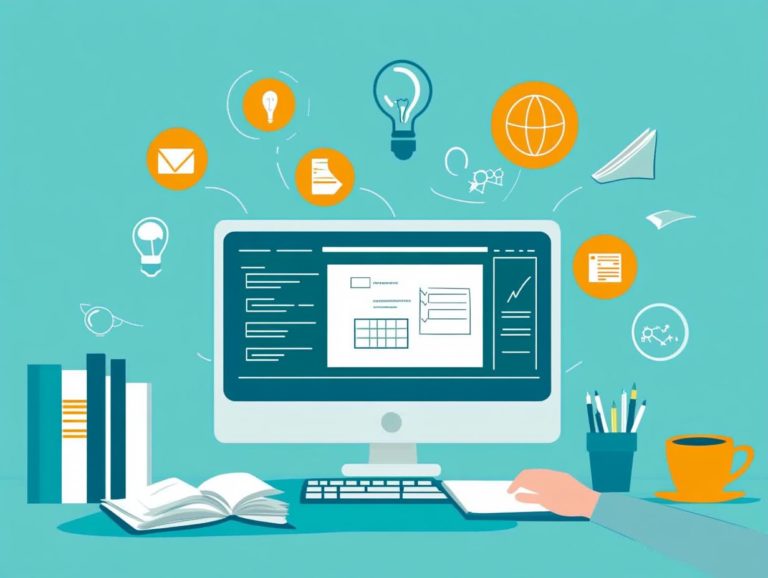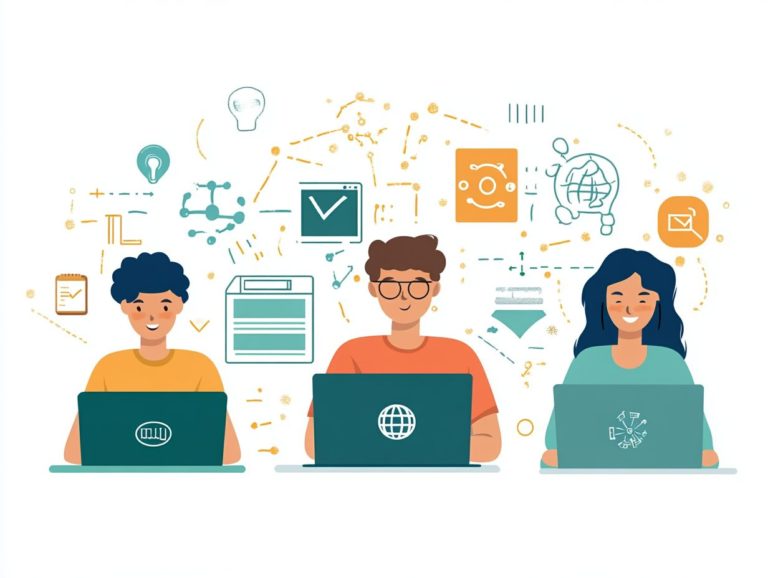The Cost-Effectiveness of E-Learning
In today s fast-paced world, e-learning stands out as a transformative force in education and training. It presents a myriad of benefits that go far beyond traditional classroom experiences.
With significant cost savings and unparalleled flexibility, e-learning enhances accessibility. It often results in improved learning outcomes for you.
To truly grasp its cost-effectiveness, it’s essential to delve into various factors. This includes initial investments and ongoing maintenance.
This exploration will guide you through these elements and showcase case studies of successful implementations. We will also provide strategies to elevate your e-learning experience.
Engage with us as we unveil the financial and educational advantages of this innovative learning approach.
Contents
- Key Takeaways:
- Benefits of E-Learning
- Factors Affecting Cost-Effectiveness
- Case Studies on Cost-Effectiveness of E-Learning
- Maximizing Cost-Effectiveness in E-Learning
- Frequently Asked Questions
- What is the cost-effectiveness of e-learning?
- How does e-learning save costs?
- Are there any hidden costs associated with e-learning?
- What are the benefits of e-learning for organizations?
- Is e-learning more cost-effective than traditional classroom learning?
- Can e-learning be equally effective as traditional classroom learning?
Key Takeaways:

- E-Learning offers significant cost savings compared to traditional classroom learning methods.
- The flexibility and accessibility of E-Learning allow for increased reach and reduced operational costs.
- Careful consideration of initial investments, maintenance, and support can optimize the cost-effectiveness of E-Learning programs.
What is E-Learning?
E-learning is a transformative approach to education that harnesses technology to elevate your learning experience. It allows you to access course materials remotely and participate in training programs, free from the limitations of traditional classrooms.
This method enhances your flexibility and accessibility. It aligns seamlessly with today s educational demands, especially in a world that increasingly relies on digital solutions for acquiring and retaining knowledge.
The concept embraces various modalities, including distance learning, which lets you study from any location, and online learning, where courses are delivered through web-based platforms.
As education continues to evolve, e-learning integrates elements of designing lessons that work well and cutting-edge learning technologies. This boosts your engagement with interactive resources, multimedia content, and personalized learning pathways.
In this digital age, where the need for continuous skill development and lifelong learning is critical, e-learning is a game-changer in today s education!
Benefits of E-Learning
The benefits of e-learning are truly multifaceted, providing significant advantages for you as a student, for educational institutions, and for the remote workforce.
You ll appreciate the enhanced flexibility in learning schedules. This allows you to study at your own pace.
The improved accessibility to a vast array of resources means you can explore topics that interest you without limitations. Higher student satisfaction rates come from personalized learning experiences that cater to your unique needs and preferences.
This ensures that your educational journey is both fulfilling and effective.
Cost Savings
eLearning offers substantial cost savings compared to traditional classroom setups. You know how quickly expenses can pile up with tuition, course materials, and facility usage in a conventional setting?
eLearning provides a far more economically viable option for both you and educational institutions. By eliminating the need for physical infrastructures like classrooms and libraries, the financial benefits are significant.
You enjoy lower tuition fees, while schools can redirect their funds to enhance their programs. This creates a win-win situation.
Plus, with the flexibility of online courses, you can work while you study. This effectively reduces opportunity costs, allowing you to earn an income without sacrificing your educational ambitions.
Don t miss out on financial aid opportunities that can make education affordable for you! Financial aid serves as a bridge for many who find even online education dauntingly priced.
This further democratizes learning opportunities and paves the way for your academic success.
Flexibility and Accessibility
Flexibility and accessibility are essential in eLearning. They allow you to tailor your educational experiences to align with your unique schedule and learning preferences. This adaptability is vital for meeting different lifestyles, especially for those in the remote workforce. Ultimately, it enhances your satisfaction and engagement.
In a world where juggling work, family, and personal commitments can feel like an Olympic sport, online learning platforms emerge as key players. They create a more inclusive educational landscape. These platforms offer a wide array of courses that cater to different interests while incorporating accessibility features like adjustable text sizes and audio descriptions.
These enhancements enable you and others with disabilities or varied learning styles to engage fully with the content. By addressing these unique needs, eLearning environments cultivate a sense of belonging and motivation. They effectively bridge gaps and enrich the overall learning experience for everyone.
Improved Learning Outcomes

E-learning significantly enhances your learning outcomes. It harnesses various methods and technologies that boost knowledge retention and engagement. You can assess your progress through effective evaluation strategies tailored specifically to your unique learning experiences.
By incorporating multimedia resources like videos, interactive simulations, and quizzes, this approach caters to your diverse learning styles. It fosters a deeper understanding of complex concepts. Continuous feedback mechanisms are essential, allowing you to reinforce what you’ve learned and promptly address any weaknesses.
Personalized learning tools adjust your educational journey, ensuring that you progress at your own pace while still meeting critical benchmarks. These assessments not only gauge your knowledge acquisition but also provide valuable insights into your motivation. Ultimately, they create a more effective and fulfilling educational experience.
Factors Affecting Cost-Effectiveness
Several factors influence the cost-effectiveness of your eLearning initiatives. You’ll need to consider the initial investment required to develop digital courses, along with ongoing maintenance and support costs.
The effectiveness of your training programs is crucial for optimizing how educators and students use e-learning tools and technologies.
Initial Investment
The initial investment for eLearning projects can present a range of costs. This includes development expenses for course content, software, and learning platforms. Such costs can pose a significant challenge for educational institutions looking to implement effective training solutions.
Costs can vary widely depending on the type of institution. For example, private universities may set aside larger budgets for high-quality multimedia content and interactive features, aiming to attract a diverse student body. Community colleges, however, often focus on essential online tools that ensure accessibility for local students, operating with tighter budgets.
It s crucial to consider ongoing maintenance fees, software updates, training for instructors, and administrative expenses related to managing eLearning courses. All of these factors contribute to the overall cost structure that institutions must navigate, making careful planning essential.
Keep Your eLearning Fresh and Effective!
Ongoing maintenance and upkeep of your eLearning systems are essential for ensuring the effectiveness of your training programs. Stay ahead with regular system updates and enhancements to learning technologies. This allows you to keep pace with the ever-evolving educational needs and technological advancements.
Moreover, reliable user support is crucial in elevating the learning experience. It enables users to navigate challenges with confidence. When technical hiccups occur, prompt assistance ensures that users stay engaged and that learning objectives are achieved without unnecessary delays.
Incorporating the latest technological advancements can significantly enhance interactivity and user engagement. This blend of timely updates, robust support, and cutting-edge features ultimately transforms your eLearning platform into a dynamic environment that accommodates diverse learning styles. It leads to improved retention and comprehension among learners.
Take charge of your learning journey today! Discover eLearning solutions that fit your lifestyle and needs!
Training and Support
Effective training and support for both educators and students are vital for your eLearning initiatives. They help you navigate learning tools and instructional design easily, enhancing your educational experience.
In today s fast-paced digital world, adapting to various platforms and tools is crucial. Institutions that prioritize comprehensive onboarding sessions, ongoing webinars, and accessible resources empower you to engage confidently with content and maximize interactive elements like forums and assessments.
Tailor your support to boost learning and build community! Programs like mentorship accommodate diverse learning styles and needs, fostering collaboration. These efforts cultivate a culture of continuous improvement, significantly boosting retention rates, participation, and overall satisfaction for instructors and learners in the eLearning environment.
Case Studies on Cost-Effectiveness of E-Learning

Case studies from renowned organizations like Brandon Hall Group and Ernst & Young highlight the impressive cost-effectiveness of eLearning solutions. These studies provide insights into how companies like MSD and Vestas have successfully implemented these training programs.
By doing so, they’ve enhanced employee development and retention, achieving significant reductions in expenses.
Examples of Successful Implementation
Successful eLearning implementation is evident in companies like BCD Travel and CaixaBank, as well as educational institutions like Champlain College. These organizations embrace innovative eLearning solutions to elevate training programs and enhance learning outcomes.
For instance, BCD Travel has adopted a blended learning approach, integrating interactive modules and real-time feedback to ensure employees grasp theoretical concepts and develop practical skills. Similarly, CaixaBank uses gamification techniques to engage employees during compliance training, showing how incorporating rewards can amplify learning.
Champlain College leverages Learning Management Systems (LMS) like Moodle, enhancing course offerings and allowing for personalized learning paths to meet diverse student needs. These strategies illustrate how adaptive learning technologies and engaging content significantly improve retention and application in both corporate and academic settings.
Maximizing Cost-Effectiveness in E-Learning
Maximize cost-effectiveness in eLearning through strategic planning and best practices that utilize technology effectively. This ensures you provide high-quality learning experiences that meet institutional goals and cater to students’ needs.
Strategies and Best Practices
Enhance your learning efficiency and overall effectiveness by implementing proven strategies and best practices in eLearning. This helps optimize training solutions while boosting student engagement and satisfaction.
Utilize adaptive learning technologies to tailor the educational experience to meet individual student needs, creating personalized pathways in coursework. Combine these tools with interactive multimedia elements, such as videos and simulations, to foster greater retention and accessibility.
Employ social learning strategies by integrating discussion forums and collaborative projects to encourage peer-to-peer interaction, deepening understanding. Regular assessments and feedback mechanisms like quizzes and real-time analytics help identify areas needing further support, ensuring a responsive learning environment for all students.
Frequently Asked Questions
What is eLearning?
E-learning refers to using electronic technologies to access educational curriculum outside a traditional classroom.
How can eLearning benefit organizations?
It enhances employee training flexibility, reduces costs, and improves retention through engaging and interactive content.
What technology is needed for eLearning?
Basic requirements include a computer or tablet, internet access, and any required software like a Learning Management System (LMS).
What is the cost-effectiveness of e-learning?

E-learning is an efficient and affordable way to learn. It uses electronic technology instead of traditional in-person methods.
How does e-learning save costs?
E-learning saves costs by eliminating the need for physical classrooms, printed materials, and travel expenses. It also reduces the time and resources needed for creating and updating course content.
While e-learning can be more cost-effective overall, there may be hidden costs such as setting up and maintaining the technology, licensing fees, and additional technical support. It is important to consider these factors when evaluating the cost-effectiveness of e-learning.
What are the benefits of e-learning for organizations?
E-learning can dramatically slash training costs for organizations! It’s a flexible and efficient way to educate employees. It also allows for consistent and standardized training across all locations.
Is e-learning more cost-effective than traditional classroom learning?
Absolutely! Studies reveal that e-learning can save organizations an astonishing 50-70% in training costs compared to traditional classroom learning. However, the cost-effectiveness may vary depending on the specific needs and resources of each organization.
Can e-learning be equally effective as traditional classroom learning?
Yes, e-learning has been proven to be just as effective as traditional classroom learning in terms of knowledge retention and skill development. With advancements in technology and a variety of interactive learning tools, e-learning can often be more engaging and personalized for learners.






